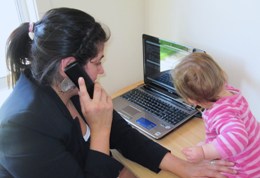08 October 2014
 Mothers juggling paid work and care responsibilities are still struggling to find work-life balance in 2014, according to the latest Australian Work and Life Index (AWALI) national report from the University of South Australia’s Centre for Work + Life.
Mothers juggling paid work and care responsibilities are still struggling to find work-life balance in 2014, according to the latest Australian Work and Life Index (AWALI) national report from the University of South Australia’s Centre for Work + Life.
Women who are caring for children as well as participating in paid work report the worst work-life balance of all workers in the 2014 AWALI survey – a finding that has been consistent since the research was first conducted in 2007.
But the 2014 report, titled The Persistent Challenge: Living, Working and Caring in Australia in 2014, highlights that the caring responsibilities of the current workforce are increasingly diverse and go well beyond the care of children:
- Nearly 20 per cent of Australian employees are caring for an elderly person or someone with a chronic illness or disability, while 44 per cent of employees are parents.
- The majority of workers aged over 45 are providing care and assistance to an elderly person; 70 per cent of men and almost 85 per cent of women in this age group report they are juggling paid work and caring for an elderly relative or friend.
The study indicates that these other types of care responsibilities are associated with an equivalent increase in work-life interference as child care, and workers combining child care with other care responsibilities experience extremely high levels of work-life interference.
Centre for Work + Life Acting Director and co-author of the AWALI 2014 report Dr Natalie Skinner says it is important that government and organisational policies recognise the work-life strains faced by these types of carers.
“Our research reveals that many Australian workers are struggling with balancing paid work and caring responsibilities which go beyond those with young children. This trend is set to continue as the population ages and people are remaining in the paid workforce for longer,” Dr Skinner says.
AWALI interviewed more than 2600 working Australians across a range of different industries and occupations, living in capital cities and regional areas, from different age groups and backgrounds, to build a representative picture of the experience of working in Australia in 2014.
“This survey is important because it measures where we’re at in terms of Australians’ experiences of paid work and how it impacts on other areas of our lives,” Dr Skinner says.
“The findings are useful in evaluating the effectiveness of government and organisational policies such as paid parental leave schemes and the right to request flexible work arrangements.”
With the 2014 report again finding that working mothers have the highest work-life interference, nearly 60 per cent of women reported they feel chronically pressed for time.
This is compared to just under half of men who feel the same way, as women continue to do the majority of domestic work while also trying to balance paid work.
 The 2014 AWALI also shows that workers with caring responsibilities other than young children, such as caring for an elderly relative or an older child with a disability are experiencing high levels of strain.
The 2014 AWALI also shows that workers with caring responsibilities other than young children, such as caring for an elderly relative or an older child with a disability are experiencing high levels of strain.
“Our research shows that caring for an elderly person or someone with a chronic illness or disability has the equivalent work-life interference as caring for a young child,” Dr Skinner says.
“As a society we need to recognise the unpaid care work that is undertaken on a daily basis by ordinary Australians who are also juggling paid work responsibilities. We need to see a shift in attitude and real actions in the workplace backed up by policies that support these employees.”
Working long hours (48+ per week), working more hours per week than preferred, and unsocial hours (evenings, nights and weekends) are also associated with higher levels of work-life interference. Managers, machinery operators and drivers, corporate professionals and community service workers are among the occupations with the worst work-life balance.
Dr Skinner says the gaps that often emerge between policy and practice are widely observed.
She says initiatives to address working time require a holistic approach that examines the factors encouraging or requiring long hours, inflexible schedules or forgoing leave entitlements. These include workloads, performance expectations, implicit and explicit rewards for long hours (links to promotions and other rewards), staffing levels, job design and organisational culture.
“There is an expectation and cultural assumption that workers are willing and able to prioritise work over other life activities such as care for children or elders,” she says.
“Multifaceted policy approaches are needed that set the foundation for change. More inclusive employment, better quality part-time work and a greater focus on men’s uptake of flexible work are likely to alleviate some of the burden and causes of work-life conflict across industries, alongside cultural shifts in workplace gender norms.”
The report states that gender culture in Australia has proven particularly resilient, with contradictory norms that support women’s increased employment participation yet still insist that mothers’ primary responsibilities are to their families.
Contact for interview: Dr Natalie Skinner office (08) 8302 4250 mobile 0410 765 279 email Natalie.skinner@unisa.edu.au
Media contact: Kelly Stone office 8302 0963 mobile 0417 861 832 email Kelly.stone@unisa.edu.au




